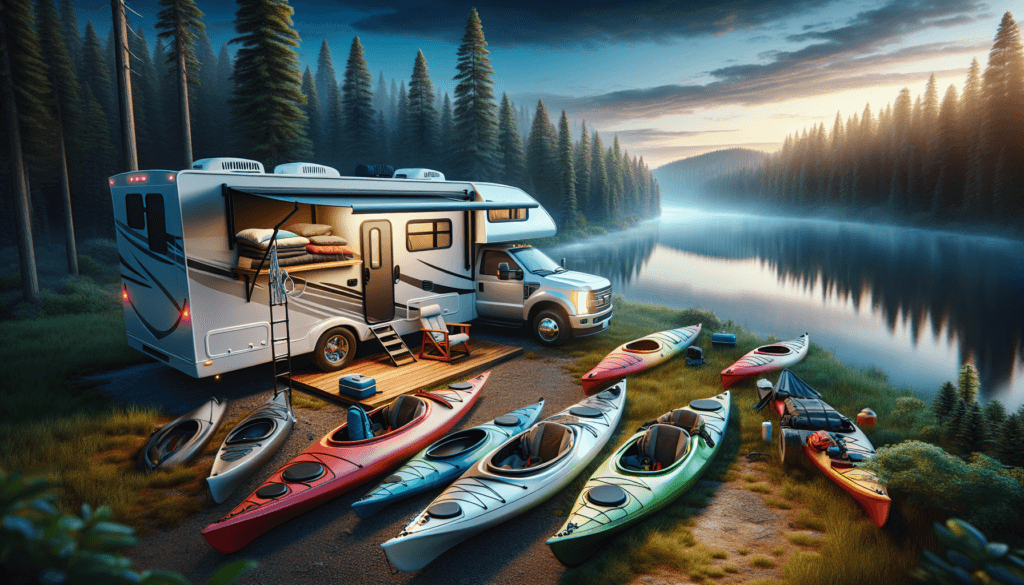Imagine yourself embarking on the ultimate outdoor adventure – RV camping with kayaks! In this article, we will share invaluable tips to make your paddling experience a thrilling and unforgettable one. Whether you are a seasoned kayaker or new to the sport, we’ve got you covered. From choosing the perfect RV for transporting your kayaks to finding the best camping spots that provide easy access to waterways, we will guide you every step of the way. So grab your paddle, hop in your RV, and get ready for an exhilarating journey of exploring breathtaking lakes, rivers, and oceans. Let’s dive in!

Choosing the Right RV for Kayak Camping
When it comes to kayak camping, choosing the right RV is crucial to ensure a smooth and enjoyable adventure. One of the first considerations is the size and weight of your kayaks. RVs come in various sizes and have different weight capacities, so it’s important to know the dimensions and weight of your kayaks before selecting an RV. This way, you can determine if the RV can accommodate your kayaks without exceeding its limitations.
Another important factor to look for in an RV is storage options for your kayaks. RVs with designated kayak storage compartments or racks can make it much easier to transport and store your kayaks securely. These compartments or racks should be spacious enough to fit your kayaks properly, ensuring that they are protected during travel.
Additionally, it’s essential to ensure that the RV you choose has a hitch and towing capacity suitable for transporting your kayaks. This will enable you to safely tow a kayak trailer or attach kayak racks to the back of your RV. Double-check the RV’s specifications and consult with the manufacturer or a trusted RV dealer to determine if it can handle the weight and stress of towing your kayaks.
Essential Kayak Gear for RV Camping
Before embarking on your RV camping and kayaking adventure, it’s important to make sure you have all the essential gear for a safe and enjoyable experience. Here are some must-have items to include in your kayak gear checklist:
Paddles: Choose paddles that are durable and appropriate for your kayaking activities. Consider factors such as length, weight, and material when selecting paddles.
Life jackets: Safety should always be a top priority, and wearing a properly fitted life jacket is crucial when kayaking. Make sure everyone on board has a U.S. Coast Guard-approved life jacket.
PFD (Personal Flotation Device): In addition to life jackets, it’s advisable to carry a PFD for each kayaker. These devices are designed to provide additional buoyancy and can be worn over or under the life jacket.
Dry bags: Keep your valuables, extra clothes, and other gear safe from water damage by using dry bags. These waterproof bags are essential for storing and protecting your belongings during kayaking trips.
Repair kit: Accidents happen, so it’s wise to carry a kayak repair kit with you. This kit should include items like patches, adhesive, and a pump to fix any minor damages or punctures that may occur.
Paddling gloves: Protect your hands from blisters and enhance your grip on the paddle by wearing paddling gloves. These gloves can also provide some insulation in colder weather.
Sunscreen and hat: Protect yourself from the sun’s harmful rays by applying sunscreen and wearing a hat. The reflection of sunlight off the water can intensify the UV exposure, so be sure to reapply sunscreen frequently.
First aid kit: It’s always important to have a first aid kit on hand for any potential injuries or emergencies. Stock it with basic supplies like bandages, adhesive tape, antiseptic ointment, and any necessary medication.
Navigation tools: Carry a reliable map, compass, or GPS device to help navigate unfamiliar waters. These tools can be valuable in ensuring you stay on track and reach your desired destinations safely.
Camping gear: Since you’ll be combining RV camping with kayaking, make sure to pack all the necessary camping gear such as tent, sleeping bags, cooking equipment, and food storage containers. Plan your meals ahead to ensure you have enough provisions for the duration of your trip.

Planning Your RV Camping and Kayaking Routes
Proper planning is crucial when it comes to RV camping and kayaking. To make the most of your trip and ensure a smooth experience, follow these steps:
Research kayaking destinations: Start by researching different kayaking destinations that pique your interest. Consider factors such as scenery, difficulty level, and proximity to your RV camping spots.
Check for kayak launch points and facilities: Once you’ve identified potential kayaking destinations, find out if they have designated kayak launch points and facilities. Look for areas with easy access to water and amenities such as parking, restrooms, and picnic areas.
Consider the difficulty level of the waterways: It’s important to assess the difficulty level of the waterways you plan to kayak. Factors such as currents, tides, and potential hazards should be taken into account. Choose routes that match your skill level and experience.
Plan for camping spots near water access points: To maximize your kayaking experience, consider RV camping spots that are near water access points. This way, you can easily launch your kayaks and enjoy the convenience of being close to the water.
Account for weather conditions and tides: Stay informed about local weather conditions and tides before setting out on your kayaking adventures. Adverse weather or strong tides can affect the safety and enjoyment of your trip, so plan accordingly and make any necessary adjustments to your itinerary.
By carefully planning your RV camping and kayaking routes, you can ensure that you make the most of your time and have a memorable experience on the water.
Transporting and Storing Kayaks on an RV
Transporting and storing your kayaks properly is essential to prevent damage and ensure their longevity. Here are some tips to consider:
Invest in kayak racks or trailers: To securely transport your kayaks, consider investing in kayak racks or trailers specifically designed for RVs. These racks and trailers provide a safe and efficient way to store and transport your kayaks, regardless of the RV’s size.
Secure kayaks properly during travel: Once your kayaks are loaded onto the RV, ensure they are securely fastened to the racks or trailers. Use sturdy straps or tie-downs to secure the kayaks and double-check that they are snug and immobile.
Protect kayaks from damage or theft: RV camping often involves leaving your kayaks unattended at campsites or storage areas. To protect your kayaks from theft or damage, consider using additional security measures such as cable locks or kayak-specific locking mechanisms. Additionally, cover your kayaks with a tarp or specialized kayak cover to protect them from harsh weather conditions or debris.
By following these transportation and storage tips, you can ensure that your kayaks remain in excellent condition throughout your RV camping adventures.

Preparing for a Safe and Enjoyable Kayaking Experience
While kayaking can be an exhilarating experience, it’s important to prioritize safety and take necessary precautions to ensure an enjoyable trip. Here are some tips to help you prepare:
Check local laws and regulations: Familiarize yourself with the local laws and regulations regarding kayaking in the areas you plan to visit. This knowledge will help you understand any specific regulations or restrictions, ensuring you comply with all necessary requirements.
Learn and practice proper paddling techniques: Before hitting the water, take the time to learn and practice proper paddling techniques. This will not only make your kayaking experience more efficient but also reduce the risk of accidents or injuries.
Take safety precautions on the water: Always wear your life jacket or PFD while kayaking, even if you’re a confident swimmer. In addition, inform someone about your planned route and estimated return time, especially if you’re going on a solo kayaking trip.
Stay hydrated and nourished: Kayaking can be physically demanding, so it’s important to stay hydrated and nourished throughout your adventure. Bring an ample supply of water and pack nutritious snacks to refuel along the way.
Stay aware of your surroundings: While enjoying the beauty of nature, it’s crucial to stay aware of your surroundings at all times. Watch out for other boaters, potential hazards, or changes in weather conditions. Being alert can help you avoid accidents or unforeseen dangers.
Enjoy wildlife responsibly: Kayaking often provides opportunities to encounter wildlife. While it can be tempting to get close for a better view or photo, always remember to respect their space and observe from a safe distance. Move slowly and quietly to avoid disturbing the animals or their habitat.
By taking these precautions and being well-prepared, you can have a safe and memorable kayaking experience while RV camping.
Setting Up Camp with Kayaks
Choosing an ideal campsite and setting up a kayak-friendly layout can greatly enhance your RV camping and kayaking experience. Consider the following tips:
Choose a campsite near water: To enjoy the convenience of easy access to kayaking, select a campsite that offers proximity to suitable water bodies. Look for campgrounds situated near lakes, rivers, or coastal areas that allow kayaking activities.
Set up a kayak-friendly camp layout: When setting up your campsite, arrange your gear and equipment in a way that facilitates the loading and unloading of your kayaks. Keep your kayaks near the RV, and store other camping essentials in an organized manner to create a clutter-free space for hassle-free kayaking preparations.
Use a kayak lock system for security: Theft of kayaks is a real concern, so it’s important to take adequate security measures. Invest in a reliable kayak lock system that secures your kayaks to your RV or nearby fixed structures, minimizing the risk of theft.
Store kayaking accessories efficiently: Keep your kayaking accessories like paddles, life jackets, and dry bags in easily accessible storage compartments or designated areas within your RV. This makes it convenient to grab them when needed, ensuring a smoother kayaking experience.
By strategically setting up your campsite and making it kayak-friendly, you can streamline your kayaking routines and maximize your enjoyment during your RV camping adventure.

Tips for Launching and Retrieving Kayaks
Launching and retrieving your kayaks properly can make a significant difference in the success and smoothness of your kayaking experience. Follow these tips for a seamless process:
Use proper kayak launching techniques: When launching your kayaks, ensure you are in a suitable area with enough space and water depth. Avoid shallow areas or areas with any potential obstacles that could damage the kayak. Gently place the kayak in the water, making sure it’s well clear of the shore before boarding.
Assess water conditions before launching: Before getting on the water, assess the current conditions. Look out for strong currents, tides, or waves that could make launching or maneuvering difficult. If the conditions seem unfavorable, consider postponing your kayaking plans or choosing a safer location.
Coordinate with fellow kayakers for safety: If kayaking with a group, coordinate with your fellow kayakers before launching. Establish clear communication and ensure everyone is ready and aware of the planned route. Having a buddy system can add an extra layer of safety and fun.
Practice efficient kayak retrieval: After your kayaking excursion, retrieve your kayaks with care. Approach the shore slowly and choose a suitable spot for landing. Once on land, make sure the kayaks are well clear of the water and secure them before unloading your gear.
Clean and dry kayaks before storage: Before storing your kayaks, take the time to clean and dry them thoroughly. This helps prevent the growth of mold or mildew and prolongs the lifespan of your kayaks. Pay special attention to cleaning out any sand, dirt, or debris that may have accumulated during your kayaking trip.
By following these tips, you can launch and retrieve your kayaks efficiently and safely, ensuring a smooth and enjoyable experience for everyone involved.
Managing Limited Water and Waste Resources
RV camping often involves managing limited water and waste resources to ensure sustainability and minimize environmental impact. Here’s how you can do your part:
Conserve water while camping: Practice water conservation by taking shorter showers, turning off taps when not in use, and using water-efficient appliances and fixtures. Consider reusing water for certain tasks, such as rinsing dishes or watering plants, to further minimize water consumption.
Dispose of waste responsibly: Follow proper waste disposal procedures at your campsite, ensuring that you dispose of trash and recyclables in designated bins. Avoid littering or leaving waste behind, and always leave your campsite cleaner than you found it.
Use environmentally friendly cleaning products: When cleaning your RV or your gear, opt for environmentally friendly cleaning products. These products are less harmful to the environment and help maintain the water quality in the areas where you go kayaking.
By being mindful of your water and waste usage, you can enjoy your RV camping and kayaking adventures while minimizing your ecological footprint.

Dealing with Hazards and Emergencies
While precautions can minimize risks, it’s important to be prepared for hazards and emergencies that may arise during your RV camping and kayaking trips. Here are some tips to keep in mind:
Prepare for emergencies with necessary equipment and knowledge: Carry essential emergency equipment, such as a first aid kit, a fire extinguisher, and a tool kit, in your RV. Additionally, familiarize yourself with basic first aid procedures, CPR, and other necessary emergency protocols.
Know the signs and dangers of hypothermia: Kayaking in colder weather or water can put you at risk of hypothermia. Be aware of the symptoms and take appropriate measures to prevent and treat it. Dress in appropriate layers and have extra clothing and blankets on hand to keep warm.
Be cautious of wildlife encounters: While enjoying the great outdoors, always respect wildlife and keep a safe distance. Research the local wildlife in the areas you plan to visit, and follow any guidelines or regulations regarding wildlife encounters. Avoid feeding or approaching wild animals to prevent confrontations or potential harm.
Have a communication plan in case of emergencies: Establish a communication plan with your fellow RV campers and kayaking companions. Share important contact information and establish a designated meeting point in case you get separated or face an emergency situation.
By being prepared for hazards and emergencies, you can ensure the safety of yourself and your fellow adventurers, allowing you to enjoy your RV camping and kayaking trips with peace of mind.
Maintaining and Cleaning Kayaks During RV Camping
Proper maintenance and cleaning of your kayaks are essential to prolong their lifespan and keep them in optimal condition. Here’s what you can do:
Inspect kayaks for damage regularly: Routinely inspect your kayaks for any signs of damage, including cracks, leaks, or dents. Address any issues promptly to prevent further damage and ensure your safety on the water.
Clean kayaks after each use: Clean your kayaks thoroughly after each use to remove any dirt, salt, or debris that may have accumulated. Use mild soap, warm water, and a soft brush or sponge to clean the surface of the kayaks. Rinse them thoroughly and allow them to dry before storing.
Store kayaks in a safe and dry location: When not in use, store your kayaks in a safe and dry location, away from direct sunlight and extreme temperatures. Ideally, place them on kayak racks or in a designated storage area within your RV. Protect them with a specialized kayak cover or use a tarp to shield them from dust, UV rays, and any potential damage.
By maintaining and cleaning your kayaks regularly, you can ensure their longevity and enjoy many more RV camping adventures with them.
As you plan your RV camping and kayaking trip, keeping these tips in mind will help ensure a smooth and enjoyable experience. From selecting the right RV to choosing the essential gear and planning your routes accordingly, every aspect plays a key role in making your kayak camping adventure a success. Prioritize safety, be mindful of the environment, and embrace the freedom and tranquility of exploring the waterways with your kayak while RV camping. Happy paddling!


